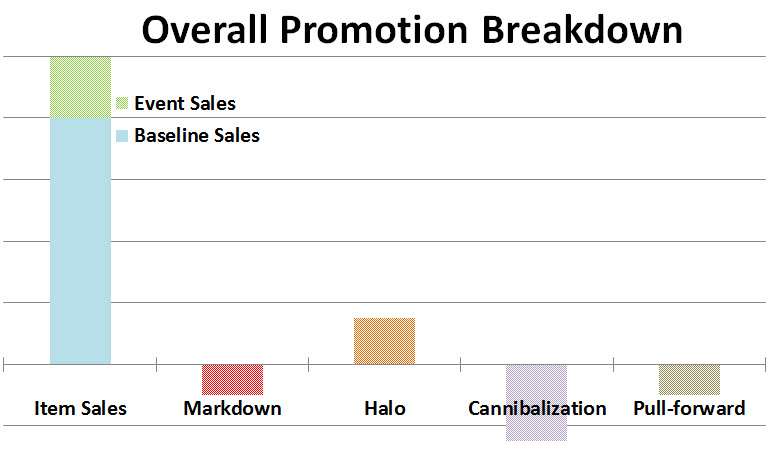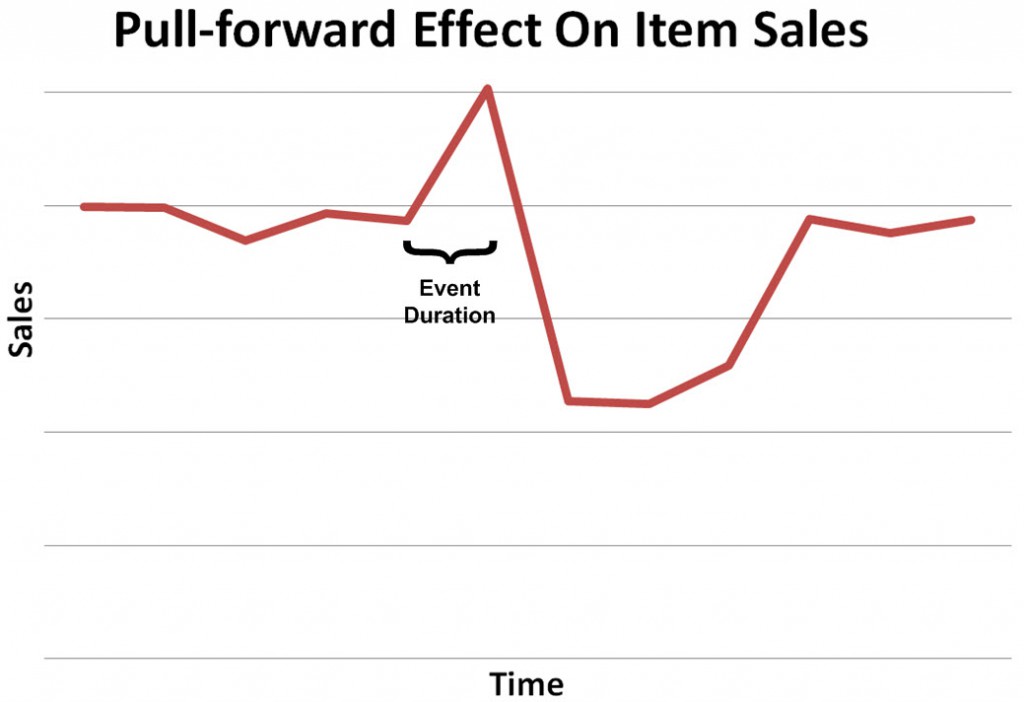One of the most popular posts on our blog is the ‘3 strategies for measuring sales lift’, and we’ve received numerous requests for a follow up on the topic. So, with this post we’d like to take this further and discuss how retailer marketers should actually analyze the overall performance of a promotion. (If you would like the sales lift automatically calculated for you, please visit our retail marketing metrics page.)
Regardless of which strategy is utilized to calculate baseline, a holistic approach to measuring lift of a promotion requires that we view the performance of a promotion as not just the individual promotion but as a promotion that can impact sales of other items within the store. To start let’s fist look at the formula of for calculating the total impact of a promotion:
Overall Lift = Lift in Promoted Item Sales + Halo – Cannibalization – Pull-forward
Now, let’s drill down into the each of the components and define them.
Lift in Promoted Item Sales:
This is the difference between when the item was promoted, and its relative baseline. Have a look at the ‘3 strategies for measuring sales lift’ for a deeper dive into calculating this particular portion of the contribution to the overall lift.
Halo:
No, we aren’t taking about the video game. The Halo effect occurs when promoting one item influences us to purchase another item. For example a week prior to super bowl, your favorite grocery chain decides to promote Pepsi. That in turn influences you to buy a bag of Doritos. This would be considered the halo effect of promoting Pepsi, the purchase decision spills over from the beverages category to snacks. This seems intuitive, but you may be asking yourself, well how can we determine that the sales of one item influences another?
The solution is simple and is known as basket analysis. Look at historical transactional data across multiple promotional periods and analyze all baskets that contained the item promoted and determine among all those baskets which were the common items that were not on promotion. What you should get is something more in the form of 60% of baskets that had Pepsi also had Doritos. Since Doritos was not promoted, any lift we see in sales to Doritos during that promotional period, can be attributed to Pepsi provided we do not see significant correlation between Doritos and another promoted item.
This information is vital as it allows us to determine the halo effect of the promotion at the same time informs us not to mark down correlated items at the same time as we would be giving up margin unnecessarily.
Cannibalization:
Cannibalization in promotional performance analysis is defined as a promoted item increasing its own sales but, decreasing the sale of another item in the same category that was not promoted. This happens quite often when you have two competing commodity brands with the same quality, and the consumer is indifferent about using one over another. Let’s take two diaper brands; Pampers and Huggies as an example, if one brand goes on sale, and the consumer is indifferent about using one over the other, they will purchase the promoted brand. This in turn will cannibalize the sales of the other brand and cause it to drop. So how do you go about measuring the impact of cannibalization?
There is a simple solution to this too. If you look at historical promotions of the item, and the impact it had on its category, and its competing items, they would be able to calculate an overall cannibalization impact within the category. In the case of diapers, you would look at all the similar quality diapers and examine the impact of promoting one over the other and determine the overall impact on the category. This is the fundamental reason behind why retailers analyze category performance rather than item performance. With commodities, consumers tend to purchase the cheaper or promoted product. Therefore the promoted item’s sales may lift but the category sales can drop as the markdown on the promoted item cannibalizes sales of the other items in the category, and contributes to a smaller overall category lift. Therefore to measure the cannibalization one needs to look at the historical promotional performance of ‘liked’ competing items grouped as a category, and understand the overall performance of the category when one was marked down.
Pull-Forward:
This is something Hi-Lo retailers are not always considering but it has significant effect on an item and categories sales over time. The pull-forward effect occurs when consumers see a price of a commodity they regularly purchase, which has a long shelf life (i.e. detergent) go on promotion. When the item goes on promotion, the consumer tends to buy a significantly larger volume than they usually purchase. They stock-up on the product for a period of time and therefore they would not buy the item on their regular frequency until they are out of stock. This again sounds intuitive, but it might seem difficult to determine.
To calculate pull-forward, you would need to again look at historical promotional data, and determine the effect on sales post promotion. So if an item was promoted for a week, and assuming this item is purchased every 3 weeks by the consumer, and it has a 4 week shelf life, one would look at one month of sales data post the promotional date to see whether the item’s weekly sales is below the baseline. If it is below, it would be considered a pull-forward effect, provided another item in the category is not promoted and did not record a lift. With commodities one needs to consider pull-forward as an impact not only to item sales but also category sales as the promoted item that is being stocked by the consumer can impact overall category performance for a period of time too.
As a final note I want to emphasize the importance of having access to historical promotional performance before attempting any of the analysis mentioned above. Additionally the calculation to perform the overall lift is a tool that can be used post-event, or prior in your ad planning process when marketing or merchandising need to forecast sales impact of a promotion.
Visit our retail marketing metrics page to see how we calculate the sales promo lift for you!




